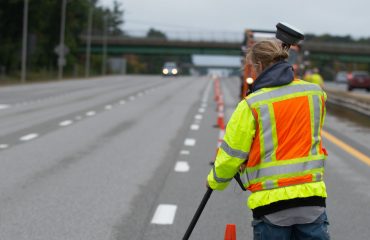What’s the best way to build a successful, diversified surveying firm? For Michael Toupin and Christopher Oyler of Surveyors On Site (SOS) based in Windsor, Ontario, Canada, the answer involves using state-of-the-art survey technology, including robotic total stations, 3D laser scanners, network GNSS, portable internet connectivity and underground service locators. The company policy was aimed at reducing costs and raising the quality of deliverables for clients, and this approach has led to rapid growth for the firm, which was founded in 2011. It has also enabled SOS to take on work in difficult survey specialties, including high-rise construction, subsurface layout (tunnels and utilities), precision industrial layout, underground mine surveying, building information modeling, and hydrography.
For work on large sites, the firm uses a Leica Nova MultiStation, an instrument that combines scanning capacity with a highly precise robotic total station. “It’s not as fast as a dedicated scanner,” Oyler explains, “but if you set the point spacing correctly it’s a very fast way to do topographic surveys, and a great way to safely get volumes in stockpiles and to survey trash sites.”

And, importantly, “The Nova is also a one second instrument.” That means SOS can always use the MultiStation to set control and do the precise layout work that the company has staked its reputation on. One of the most noteworthy applications in which SOS has used the MultiStation is for surveying and layout on the early works projects that are laying the groundwork for construction on the Gordie Howe Bridge connecting Windsor, Ontario and Detroit, Michigan.
For conventional scanning work, SOS uses a Leica ScanStation P40. “We’ll eventually use the P40 on the Gordie Howe site when the actual span is being constructed,” says Oyler. “We know there will be a need, and it made sense to buy a ‘Cadillac’ and know how to use it well when the time comes.” Until then, SOS has kept the advanced instrument busy doing work they would normally have done with conventional instruments while benefitting from the increased speed and quality of the P40’s data acquisition. For example, survey work on a grain terminal in Windsor turned out much better than expected, thanks to the P40’s advanced scanning capabilities.
“With just three hours of work, including travel time, we produced a point cloud that proved the foundation had been poured incorrectly, and the client used that to negotiate successfully with the contractor. He was happy, and we made money for the scanning work, and for creating and hosting the TruView model.”
– Christopher Oyler, B.Sc.Eng., OLS“When we were onsite there was a lot of fog and steam coming from pipes, and normally that would have slowed down our work and degraded accuracy,” Oyler says. “But with all the redundancy the P40 offers, all of those obstructions were cleared away. We did the project in a day, instead of a week.” The firm has also adapted an inverted tripod that allows them to operate the scanner remotely and scan several manholes a day.
Similarly, SOS has used laser scanners on very small jobs, like a location of new garage construction. “With just three hours of work, including travel time, we produced a point cloud that proved the foundation had been poured incorrectly, and the client used that to negotiate successfully with the contractor,” Oyler says. “He was happy, and we made money for the scanning work, and for creating and hosting the TruView model.”
The company also uses Leica Viva TS16 robotic total stations, LS15 digital levels and GS18 T GNSS receivers, all of which are known for maximizing accuracy, speed and seamless field-to-finish workflows.
Emphasis on advanced technology and high-quality deliverables has been successful for SOS. In just seven years, the firm has become a multinational firm with headquarters in Windsor, two additional Ontario offices and an office in Livonia, Michigan. They’re also known in their region for a fleet of high quality, blaze orange survey vehicles that are regularly spotted on some of Canada’s largest infrastructure projects, including the early works projects for the Gordie Howe Bridge—a cable-stayed bridge connecting Windsor and Detroit that will likely be North America’s largest bridge project in the 2020s.
>>RELATED: Read how SOS is Mastering Control on the Gordie Howe Bridge
To learn how your organization can use technology to grow your business, please contact us.



